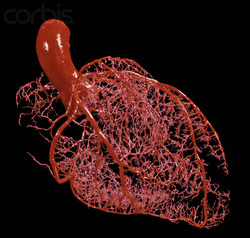 Originally stable angina and acute myocardial infarction (MI) were believed to be different diseases. Then in the 1930s it was observed that some patients with severe and sometimes prolonged rest angina sometimes went on to have an MI. This disorder was referred to as pre-infarction or crescendo angina and then was renamed unstable angina in 1971. We still use this term today to describe a group of patients who have symptoms of angina at rest but who have normal cardiac biomarkers. The World Health Organization definition of MI requires 2 out of 3 of either typical symptoms of angina, a typical ECG pattern (e.g. Q waves, ST elevation) or a rise and fall in cardiac biomarkers of myocardial necrosis. In 1991 unstable angina was responsible for over half a million hospitalizations in the United States and it was one of the most common disorders leading to admission. Nowadays we refer to patients with chest pain as having acute coronary syndromes. This term encompasses all patients with unstable angina, non-ST elevation MI and ST elevation MI under one umbrella. However there is ambiguity since the operational definition of unstable angina is made when there are new or worsening symptoms of ischemia and ischemic ECG changes with normal biomarkers. The distinction between new angina, worsening angina and unstable angina is clinically very difficult since by this definition the first ever episode of angina is unstable angina. The differentiation of unstable angina and MI now rests on the identification of abnormal levels of cardiac biomarkers. When I first started in medicine we measured serial CK, AST and LDH over 3 days and looked for the typical rise and fall in these biomarkers. Later we started using the more specific but not more sensitive CK-MB and finally we started to use to troponin. Troponin is a highly specific biomarker of cardiac muscle injury. The sensitivity of troponin is now so high that we are detecting elevated levels in many patients who had they presented to physicians 20 years ago were told they had not had an MI. In the TIMI3 trial a quarter of patients originally classified as having unstable angina based on CK-MB measurements had elevated Troponin and as the years have gone on the sensitivities of troponin assays continues to reduce. In the TIMI3 trial the cut point for MI diagnosis was 0.4ng/mL, by 2010 in the MERLIN-TIMI 36 trial the cut point was 0.04 ng/ml. In the recent PROTECT-TIMI 30 trial the cut point was 0.003ng/mL and in this trial 44% of patients were defined as having an MI at presentation with 82% by 8h. It is now evident that a large majority of patients with clinical manifestations of myocardial ischemia will have elevated levels of troponin if an assay with high enough sensitivity is used. What is also important is not just that we are detecting more MIs but this newly identified group of patients do have higher risk than those patients with undetectable troponin and as such aggressive treatment is leading to improved clinical outcomes. So in the end with ultra high sensitive troponin assays emerging into clinical practice we will be able to confidently divided patients into a group with stable angina pectoris and a group with MI and the grey zone of unstable angina with most likely be banished forever.
2 Comments
Anne Marie Cunningham
17/11/2013 03:07:55 am
Hello Richard,
Reply
Dr Arun
18/11/2013 03:29:47 am
By reducing the sensitivities are we not harming the non-cardiac patients by over treating them.
Reply
Your comment will be posted after it is approved.
Leave a Reply. |
Dr Richard BogleThe opinions expressed in this blog are strictly those of the author and should not be construed as the opinion or policy of my employers nor recommendations for your care or anyone else's. Always seek professional guidance instead. Archives
August 2023
Categories
All
|
 RSS Feed
RSS Feed

